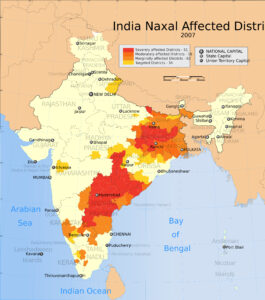
One of the biggest internal security threats in India, in the form of left-wing extremism which still persists today is naxalism.
The areas where Naxalism is most prominent are the areas which are dominated mainly by the adivasis or the tribal population. This presence is due to many reasons in which mainly geographical and historical reasons count the most and are connected to each other. Due to the geography of hills and forests of Central India, the guerilla warfare of the naxalites suits the area.
The Naxalite movement began in 1967, in a village called Naxalbari from where ‘Naxalism’ derived its name in West Bengal, near Siliguri district. This movement apparently set a model for revolt in the ‘tribal belt’ of India. In 1969, when this movement saw a decline, a revival was then done by the acclaimed leader of the movement ‘Charu Mazumdar’. He followed a ‘program of class annihilation and covert assassination’. When the terror of this movement reached its peak in 1970-71, extra-judicial killings were done by the police which moved the movement further underground and later it re-emerged in certain states. These naxalites cause disturbances to social order and have braced themselves ‘because of certain facilitative measures such as the red corridor’.
The Red Corridor is spread in 11 states with focus on Jharkhand, Bihar, Andhra Pradesh Chhattisgarh and Odisha and experiencing maoist insurgency here. These areas are underdeveloped and even though the areas have been reduced under this Corridor by the government there is still prevalence of naxalism and maoist influence. Violence and casualties are rampant in these districts and they are some of the poorest places in India. The death tolls in these areas are also very high. This corridor is a genuine concern for India as it is an internal security threat. It provides shelter and passage for the maoists to carry their activities successfully without any hindrance from the government. They have bombed many places like the railway station and attacked police camps.
The movement gained force after the merging of the People’s War Group (PWG) and the Maoist Communist Centre (MCC) in 2004 and after the formation of a new party it called itself Communist Party of India (Maoist). Chhattisgarh has the highest number of concentration of naxalite movement as it is the state surrounded by most of the states which have red corridor regions. It is predominantly a tribal state with rich mineral and forest resources. These regions of Chhattisgarh have been ‘deprived of credible governance since time immemorial’. The naxals there gradually propagated the revolutionary message among the tribals by focusing on the failing system of governance.
There have been initiatives to counter naxalism in Chhattisgarh and elsewhere for example the ‘Salva Judum’. The then government of Raman Singh claimed it to be a movement for peace to save the tribals from the evils of naxalism but was ridiculed by the naxals. It is a ‘state-sponsored militia’ and was successful in waging war against maoists’. The naxalite movement is a war between the government and the naxals.
The problem of naxalism still prevails today. Many CRPF personnel were killed in Dantewada district of Chhattisgarh recently and it is not something new at all but still an area of concern. The naxals launch attacks on the security forces. This situation is really alarming and the tribal people are also in trouble as they are worst affected and harmed by this Naxal movement. The government should introspect and should take this matter more seriously as it drains the resources of our country, only disbalancing the social and economic factors.

